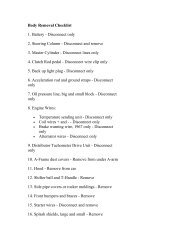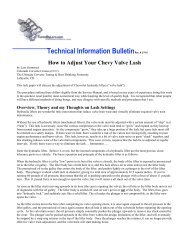Differential Rebuild Instructions - The Corvette Restoration Page
Differential Rebuild Instructions - The Corvette Restoration Page
Differential Rebuild Instructions - The Corvette Restoration Page
Create successful ePaper yourself
Turn your PDF publications into a flip-book with our unique Google optimized e-Paper software.
Setting Pinion Bearing Preload<br />
In differentials that use a crush sleeve this is relatively easy. I always use a new crush<br />
sleeve for final assembly. I use oil on the pinion nut washer surface during all assemblies<br />
and red Loctite on the pinion nut threads during the final assembly. <strong>The</strong> oil on the<br />
washer surface helps the nut turn easier while it is being tightened and the red Loctite<br />
helps keep it tight.<br />
Crush Sleeve Design<br />
On a crush sleeve design differential it usually takes between three hundred (300)<br />
and four hundred (400) foot pounds of torque to crush the crush sleeve. Over the years<br />
I have used huge breaker bars and or very strong air operated impact wrenches to<br />
crush the crush sleeve. I also proceed very slowly so that I get it right the first time.<br />
<strong>The</strong> pinion preload will be zero until the bearings contact the races. When the bearings<br />
contact the races the preload will increase very quickly. Again, I recommend taking<br />
plenty of time to set the preload carefully so that the bearings will have a long life. If<br />
the crush sleeve is over crushed and the pinion bearing preload exceeds the specified<br />
allowable range the only solution that I know of is to install another new crush sleeve<br />
and start over. After reaching the correct preload I moderately tap both ends of the<br />
pinion to seat the bearings, races and yoke. Be careful not to hit the pinion so hard that<br />
it damages the bearings. After “seating” the pinion I check the preload again to make<br />
certain that it is correct.<br />
Preload Shim Design<br />
If the differential uses shims to set the pinion bearing preload then this step may take a<br />
few times to get it right. I usually use the original shims on the first assembly or add<br />
0.003” to the original preload shims to make up for the bearings settling into the housing.<br />
When first tightening the pinion nut I am careful to tighten it slowly so as not to damage<br />
the bearing if the preload shim stack is not thick enough.<br />
If the preload is too loose then I<br />
remove shims so that the bearings<br />
will be tighter against the races<br />
and increase the preload.<br />
If the preload is too tight then I<br />
add shims so that the bearings will<br />
not be as tight against the races.<br />
I am always very careful to clean<br />
the shims completely so that there<br />
are no particles that may cause a<br />
false preload reading or cause the<br />
shim stack to change thickness<br />
over time as the vehicle is driven.<br />
Impact on pinion nut<br />
Installation Kit <strong>Instructions</strong> 7




